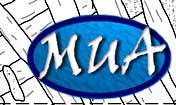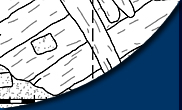Monday was the first day of field school for the terrestrial students, but not for us – we have already been doing scientific dive training since last Monday! All of the underwater archaeology field school students met at the anthropology building and the three project leaders, Dr. Bratten, Dr. Phillips, and Dr. Worth, each gave a presentation about the individual field schools. All were interesting, but we thought the underwater one was the best…of course, that could just be our biased opinions.

Andy Marr and Chris Dvorscak setting up grids.
The next day we got to head out to the barge for a full day of real nautical archaeology. We were split into 6 buddy groups and 4 of the groups spent the day rotating on the Emanuel Point II site while the other two teams went to Emanuel Point I for a tour. Those at EPII did a quick tour of the site and then worked on setting up the dredge. Our goal for right now is to get all of the loose silty muck, or fluff, sucked out of the old units.
Wednesday, we all looked forward to getting back out on the barge. Sadly, all of the dives were called off before we even left the Marine Service Center because of bad weather. There was lightning on the bay and heavy rain. Currents and wind may be manageable, but lightning is certainly no joke. We all piled into the school vans and headed up to the lab for a great presentation by Mr. Cook about ship construction. After that, some artifacts from the EP II site were brought out and we got to check out what previous field schools had recovered from the bay. Seeing the artifacts on the table definitely helped us understand what to look for during excavation.
The threat of storms is always present during the summer months in Florida. Daily rain showers, strong thunderstorms and even the occasional hurricane rear their ugly heads and put a quick stop to any dive operations scheduled or already underway. Thursday was another one of those days. A strong low pressure system worked its way through the area over several days and brought with it plenty of rain and more detrimental to our dive efforts, strong winds that kicked up three to four foot surf in Pensacola Bay. This high surf made it dangerous to reach the dive barge in our small boats. With discretion being the better part of valor and safety always being our primary concern, our site supervisors suspended dive operations for the second day in a row. There were some downcast faces but our resourceful supervisors had a backup plan. We piled into the university van and headed to Mobile, Alabama and Battlefield Park, home of the USS Alabama.
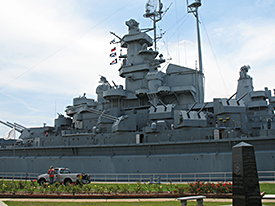
The USS Alabama.
The trip was a good experience for the members of the field school. The chance to visit the USS Alabama and many other unique vehicles so important to our nation's history really helped reinforce our love for archaeology and our past. The trip had the added benefit of allowing everyone a chance to get to know each other outside of the academic environment and build some relationships and trust. Trusting the person diving next to you in a low to zero visibility marine environment is very important. This will only help us to be more efficient and do a better job recording and preserving the sites we are working on this season.
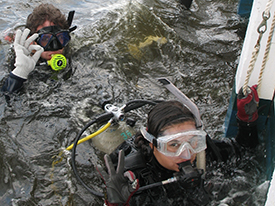
Matt Gifford and Mercedes Harrold giving the OK in heavy current.
Friday started with dreary looking weather. Rain and wind filled the sky and the forecast called for the winds to stay strong as the day progressed. The mood was sullen, but we still worked to get our gear prepped and headed out to the site hoping for the best. The rain stopped as we headed to the Bay and the clouds began to break up enough for some sun and blue sky to peek through enough to brighten our spirits. Unfortunately, the winds did not get any weaker, causing the wave and chop on the Bay to stay steady. Strong winds and near zero visibility would prove to be our biggest obstacles of the day. The safety of the divers on the site always comes first so once on the barge due consideration was given to canceling dive operations. After some discussion and the additional safety measures, supervisors agreed that dive operation would begin.
Units located mid-ship and in the stern of the vessel were the primary objectives for the day. Crews worked to remove "fluff" or layers of silt deposited back in previously excavated units. The fluff accumulates in the units when the current washes silt and other debris in the bay into the holes created while working to excavate the ship. The fluff is easy to remove. Dredge equipment easily picks the fluff up and clears the units in short order. The fluff also serves a better purpose. Removing the fluff from previous units allows students to practice using the dredge equipment with minimal risk to the site. The fluff also kicks up into the water and creates zero visibility conditions. Students have the opportunity to operate in the zero visibility environments before excavation that is more intensive begins. Divers gained both experience and confidence with their archaeology skills during the fluff removal.
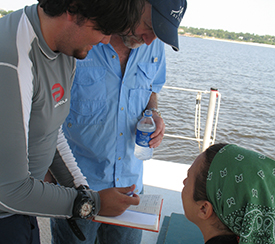
Wes Perrine, Dr. Bratten, and Sarah Everhart reviewing field book.
We successfully completed four dives with two teams operating during each dive. Areas of hull in the stern were uncovered which allowed teams to begin work excavating new units connected to the exposed hull. Progress was also made amidships in the search for the mast step or area the main mast was secured to the bottom of the ship. Today's success in these bad conditions boosted the team's spirits and instilled confidence that despite adverse conditions, they could perform their assignments successfully.
Please feel free to contact us if you have any questions or concerns at: mua@keimaps.com.
Return to Project Journal home page.
